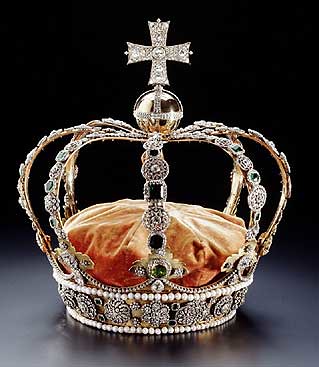 |
| Henri, Duc de Bordeaux |
His birth on 29th September 1820, as the posthumous son of Charles Ferdinand, Duc de Berry, assassinated as he left the Paris Opera House theatre seven months before, came as joyful news to French Royalists, who had feared the extinction of the senior line. He was given the baptismal name "Dieudonné" and called "l'enfant miracle". His mother, Caroline of Bourbon-Two Sicilies, each of whose four grandparents were descendants of Princess Elizabeth Stuart, Electress Palatine of the Rhine, Duchess of Orléans, was determined that her son should inherit the Bourbon Throne of France.
After the abdication of King Charles X in the July Revolution of 1830, his heir was his surviving elder son, the Dauphin, Louis Antoine, Duc d'Angoulême, who had no children from his marriage with his cousin, Marie Thérèse, the last surviving child of King Louis XVI, known as Madame Royale.
 |
| Louis Antoine, Duc d'Angoulême |
Royalists in France were divided. Liberals and constitutionalists supported the July Monarchy of the Orléans branch of the House of Bourbon, Conservatives recognised Henri V, while Legitimists and the former Ultra-Royalists considered that Charles X had no right to renounce the Throne and that, consequently, he was still de jure King of France and Navarre, until his death in 1836 at Gorizia, in Venezia Friuli. Only then was the Dauphin Louis Antoine recognised by Legitimists as Louis XIX, until his death in 1844, also at Gorizia, then Austria, today Slovenia.
From 3rd June 1844, Henri V, while the retaining the title of Comte de Chambord, by which he is known in history, became the official French Legitimist claimant. On 16th November 1846, at Brück an der Mur, in Austrian Styria, he married Archduchess Marie Therese Beatrice Gaëtane of Austria-Este and Princess of Modena. The couple remained childless.
It is perhaps the last years of Henri V, Comte de Chambord, which are the most controversial. With the defeat of Napoleon III by Prussia in 1870, France found herself with the Legitimist Maréchal Patrice de MacMahon, Duc de Magenta, as Provisional President of the Third Republic, and with a mixed Royalist majority in the National Assembly.
 |
| Louis Philippe, Comte de Paris, 1893 |
Le comte de Paris cherche à se rapprocher de son cousin. «Henri V» n’ayant pas d’enfant, le chef des Orléans est en effet convaincu qu’une restauration légitimiste ferait de lui le dauphin et permettrait de renforcer le camp monarchiste face aux républicains et aux bonapartistes. Après l’envoi infructueux de plusieurs émissaires auprès du « comte de Chambord », le comte de Paris décide de se rendre lui-même à Frohsdorf afin d’y affirmer officiellement sa soumission à l’aîné des Capétiens. Le 3 août 1873, le prince déclare ainsi à son cousin : « Je viens en mon nom, et au nom de tous les membres de ma famille, vous présenter mes respectueux hommages, non seulement comme au chef de notre maison mais comme au représentant du principe monarchique en France ». À ces mots, le « comte de Chambord » l’embrasse et lui répond : « Croyez, mon cousin, que je trouve tout naturel que vous conserviez les opinions politiques de votre famille, dans lesquelles vous avez été élevé. L’héritier du trône peut avoir ses idées comme le Roi a les siennes ». La fusion des deux courants monarchistes et la reconnaissance mutuelle des deux princes en tant que chef de famille et héritier semblent donc totalesIt was clear that after the death of Henri, Comte de Chambord, the head of the Maison de France (as distinguished from the Maison de Bourbon) would be the head of the Orléans line, i.e. the Comte de Paris. Henri himself had accepted that and it was accepted by many Legitimists, and was the default on legal grounds; since the only surviving Bourbon line more senior was the Spanish branch, which had renounced its right to inherit the throne of France as a condition of the Treaty of Utrecht. However, many of Henri's supporters, including his widow, chose to disregard his statements and this law, arguing that no one had the right to deny to the senior direct-male-line male Bourbon to be the head of the Maison de France and thus the legitimate King of France.
 |
| Reconciliation between the Comte de Chambord and the Comte de Paris. |




No comments:
Post a Comment